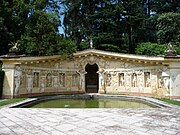Nymphaeum

A nymphaeum or nymphaion (
These monuments were originally natural grottoes, which tradition assigned as habitations to the local nymphs. They were sometimes so arranged as to furnish a supply of water, as at Pamphylian Side. A nymphaeum dedicated to a local water nymph, Coventina, was built along Hadrian's Wall, in the northernmost reach of the Roman Empire. Subsequently, artificial grottoes took the place of natural ones.
Roman period
The nymphaea of the Roman period extended the sacral use to recreational aims.
Nymphaea may be artificial grottoes, large-scale stonework to create or enhance a resemblance to a natural cave. Deliberately rough stones might be used - Pliny the Elder noted that pumice was often used to give the appearance of a cave.[3] Water was a much-desired feature; at least a trickle, often flowing over the rocks to make them glisten.[4]
Mosaics
Nymphaea were important in the architectural movement of mosaic from floor to walls and ceiling vaults in the 1st century. Initially they were often decorated with geometrical mosaics often incorporating shells, but by the end of the century could contain ambitious figure subjects.[5]
Later periods
The term nymphaeum was also applied to the fountains of water in the atrium of the Christian basilica, which according to Eusebius were symbols of purification. Phiale is an equivalent Greek term.
A nymphaeum for al fresco summer dining featuring artificial grottoes with waterflows was designed by
Gallery
-
The Nymphenbad of theZwinger palace in Dresden, Germany
-
Nymphaeum of the Villa Giulia in Rome
-
The nymphaeum at Villa Barbaro in Maser, Veneto, Italy
-
The remains of the nymphaeum in the basement of the Hôtel de Besenval in Paris
See also
Notes
- ^ A. R. A. van Aken, "Some Aspects of Nymphaea in Pompeii, Herculaneum and Ostia" Mnemosyne, Fourth Series, 4.3/4 (1951:272–284), p. 272.
- ^ Gardens of the Roman World. Patrick Bowe. The J. Paul Getty Museum, Los Angeles. pp 24-25
- ^ CHAP. 42.—PUMICE; NINE REMEDIES. The Natural History. Pliny the Elder. John Bostock, M.D., F.R.S. H.T. Riley, Esq., B.A. London. Taylor and Francis, Red Lion Court, Fleet Street. 1855. Perseus Digital Library
- ^ Gardens of the Roman World. Patrick Bowe. The J. Paul Getty Museum, Los Angeles. pp 24-25
- ^ John Coolidge, "The Villa Giulia: A Study of Central Italian Architecture in the Mid-Sixteenth Century" The Art Bulletin 25.3 (September 1943:177–225).
References
- This article incorporates text from a publication now in the public domain: Chisholm, Hugh, ed. (1911). "Nymphaeum". Encyclopædia Britannica. Vol. 19 (11th ed.). Cambridge University Press. p. 930.
- (LacusCurtius website) S.B. Plattner and T. Ashby, A Topographical Dictionary of rome, 1929: "Nymphaeum"
External links
 Media related to Nymphaea (architecture) at Wikimedia Commons
Media related to Nymphaea (architecture) at Wikimedia Commons




